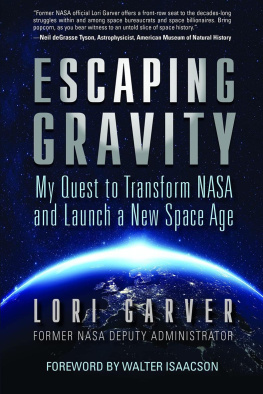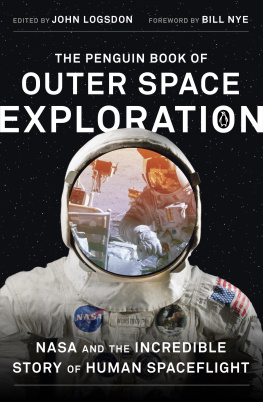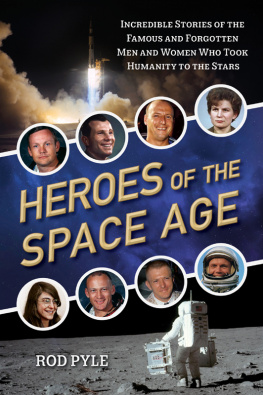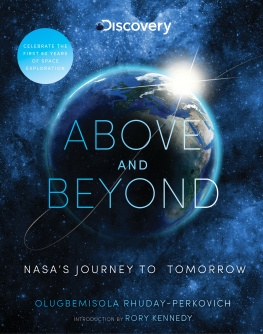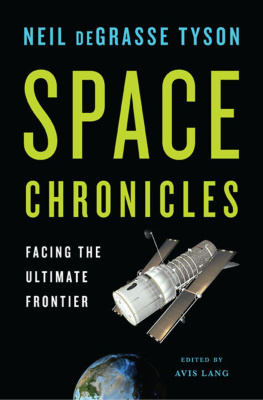PRAISE FOR ESCAPING GRAVITY
In Escaping Gravity , Lori Garver, career champion of everything space, offers a front-row seat to the decades-long struggles within and among space bureaucrats and space billionaires. From presidents to heads of agencies to astronauts to key members of Congress, she knew them all and they knew herand they did not always see eye to eye. Bring popcorn as you bear witness to an untold slice of space history.
Neil deGrasse Tyson, astrophysicist, American Museum of Natural History, and author of Space Chronicles: Facing the Ultimate Frontier
Lori Garver is a self-proclaimed space pirate, who took on NASA, the aerospace industry, and even members of Congress as part of a tumultuous groundswell that helped launch the modern commercial space industry. Told without fear or favor, her compelling tale transcends the space industry and shows us, from the inside, how Washington workswho wins, who loses, and who bears the scars.
Christian Davenport, author of The Space Barons: Elon Musk, Jeff Bezos, and the Quest to Colonize the Cosmos
As much as anyone not named Elon Musk, Lori Garver has helped prod, push, and pull NASA to embrace commercial space and all of its promise. Now, as this industry has become the envy of the world, Garver tells how it was done over the last three decades. She names names, yanks skeletons from closets, and writes illuminatingly about the brilliant future ahead of us.
Eric Berger, Ars Technica reporter and author of Liftoff: Elon Musk and the Desperate Early Days that Launched SpaceX
Garver was the clear administration leader for creating and sustaining commercial green shoots in space enterprise.... She [was] a loyal and effective advocate for Obama administration space policies and clearly had significant influence in administration space policy development.
Mark Albrecht, former executive director of the National Space Council, George H. W. Bush administration
Lori Garver was the catalyst that helped bring NASA into the new Space Age. No one has done more than Lori to stand up to parochial (and patriarchal) interests in this industry and usher in a more meaningful and sustainable space program. Escaping Gravity is an enduring story of how a woman with a different background and perspective can make a differenceand become a force to be reckoned with.
Emily Calandrelli, award-winning science communicator and host of FOXs Xploration Outer Space and Netflixs Emilys Lab
Escaping Gravity delivers the inside story of todays commercial spaceflight revolution. Before SpaceX, Blue Origin, Virgin, and XPRIZE, the space industry was an old boys club, with a handful of military defense companies. It was ultraexpensive and risk averse. Lori Garver led the charge to topple the old school and engage the entrepreneurial engine we now see today. If it werent for Lori Garvers passion and vision, we would not be on our way to the Moon and Mars today.
Peter H. Diamandis, MD, founder/chairman of XPRIZE and Singularity University and author of Abundanc e, BOLD and The Future is Faster Than You Think
If youre interested in the story of a pioneering woman revolutionizing the male-dominated space industry, read this book. If youre interested in the key early turning points of Elon Musks and Richard Bransons space efforts, read this book. If youre interested in how to affect substantive change within government, industry, and the nonprofit sector, read this book! Loris life story is filled with incredible adventures, and she has had a profound impact on humanitys future in space and on Earth.
George Whitesides, former CEO of Virgin Galactic
Lori Garvers Escaping Gravity is a must-read to understand the twenty-first century remaking of the US space industry. Her clear-eyed view from inside NASA and the halls of American power reveals the why and how behind the new Space Age thats now underway. Lori artfully gives personal introductions to dozens of influential peoplefrom the billionaires who are now household names to the politicians, officials, celebrities, entrepreneurs, executives, and more involved. Her story is gripping and personal, interwoven with never-before-told conversations, historical facts, and battles of will.
Michael Sheetz, CNBC space reporter

For David, Wesley, and Mitchellthe brightest stars in my universe.
And for all who light the path to a better future
Copyright 2022 by Lori Garver
All rights reserved, including the right to reproduce this book or portions thereof in any form whatsoever.
For more information, email
Diversion Books
A division of Diversion Publishing Corp.
www.diversionbooks.com
First Diversion Books edition, June 2022
Hardcover ISBN: 9781635767704
eBook ISBN: 9781635767735
Printed in The United States of America
1 3 5 7 9 10 8 6 4 2
Library of Congress cataloging-in-publication data is available on file
contents
Look again at that dot. Thats here. Thats home. Thats us. On it everyone you love, everyone you know, everyone you ever heard of, every human being who ever was, lived out their lives. The aggregate of our joy and suffering, thousands of confident religions, ideologies, and economic doctrines, every hunter and forager, every hero and coward, every creator and destroyer of civilization, every king and peasant, every young couple in love, every mother and father, hopeful child, inventor and explorer, every teacher of morals, every corrupt politician, every superstar, every supreme leader, every saint and sinner in the history of our species lived thereon a mote of dust suspended in a sunbeam ...
Our posturings, our imagined self-importance, the delusion that we have some privileged position in the Universe, are challenged by this point of pale light. Our planet is a lonely speck in the great enveloping cosmic dark. In our obscurity, in all this vastness, there is no hint that help will come from elsewhere to save us from ourselves.
carl sagan , Pale Blue Dot
foreword
The space age that began in the late 1950 s helped to define the twentieth century. The realms above our Earths atmosphere began to be populated with satellites and spacecraft that connected the world and revealed new knowledge of our planet and the universe. Early US exploits in human spaceflight, which sent the first humans to walk on the Moon, showed the world that we could meet bold objectives and accomplish feats previously considered unachievable.
In the class that I teach at Tulane University on the history of technology, the students discuss the drivers of innovation. Are big government projects more effective? Or are nimble entrepreneurs? The answer, of course, is that stunning breakthroughs usually involve a symbiotic mix. After being appointed by FDR in 1940 as head of the National Defense Research Committee, Vannevar Bushdean of engineering at the Massachusetts Institute of Technology and cofounder of Raytheonoversaw the government science programs that resulted in the atom bomb and electronic computer. In his seminal 1945 paper, Sciencethe Endless Frontier, he described how a collaboration of academia, business, and government would drive innovation.
The Electronic Numerical Integrator and Computer (ENIAC) was funded by the United States Army at the University of Pennsylvania. Its an origin point for the Universal Automatic Computer (UNIVAC) and most other electronic computers. Todays internet can trace its lineage to the network funded by the Defense Advanced Research Projects Agency (DARPA). For the biotech industry, the dawn was the sequencing of the human genome, largely funded by the National Institutes of Health. Innovation after innovation have followed this collaborative path.
Next page
